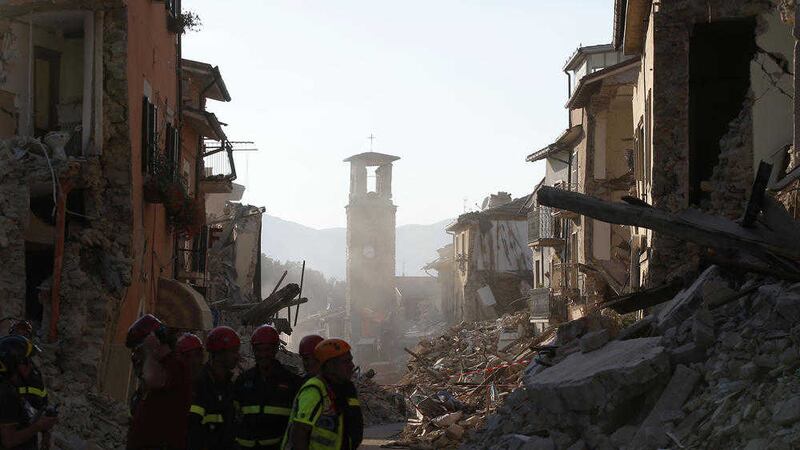ITALIAN authorities have vowed to investigate whether negligence or fraud in adhering to building codes played a role in the high death toll following last week's earthquake.
They also called for efforts to ensure organised crime does not infiltrate lucrative construction contracts to eventually rebuild much of the picturesque towns levelled in the disaster, which killed approximately 290 people in Amatrice, Accumoli and Arquata del Tronto in mountainous central Italy.
Pope Francis said he plans to visit the area to bring the people there the "comfort of faith".
Meanwhile, rescue workers pressed on with the task of recovering bodies from the rubble, with hopes of finding any more survivors dwindling four days after the tremor.
Over the past two days, six more bodies were found in the rubble of Hotel Roma in Amatrice, the medieval hill town which bore the brunt of destruction and loss of life in the 6.2-magnitude quake.
It is not clear if those six were included in the overall death toll of 290 given by authorities.
The Civil Protection agency, which combines the figures it receives from different provinces affected by the quake, said the number is lower than the previous toll of 291 dead due to a correction in the numbers from the province of Rieti, where most of the victims died.
The quake, which struck before dawn on Wednesday, also injured nearly 400 people as it flattened three medieval towns near the rugged Apennines.
Prosecutor Giuseppe Saieva, based in the nearby provincial capital of Rieti, said the high death toll "cannot only be considered the work of fate".
He added: "The fault lines tragically did their work and this is called destiny, but if the buildings had been built like in Japan they would not have collapsed."
Investigations are focusing on a number of structures, including an elementary school in Amatrice which crumbled despite being renovated in 2012 to resist earthquakes at a cost of 700,000 euro (£600,000).
With schoolchildren still on their summer holidays, the school was not in use. Many local people were shocked that the building did not withstand the 6.2-magnitude quake.
After an entire class and a teacher were killed in a 2002 quake in the southern town of San Giuliano di Puglia, Italian officials had pledged that the safety of schools, hospitals and other critical public buildings would be guaranteed.
Questions also surround a bell tower in Accumoli which collapsed, killing a family of four sleeping in a neighbouring house, including a baby aged just eight months and a seven-year-old boy.
That bell tower also had been recently restored with special funds allocated after Italy's last major earthquake, which struck nearby L'Aquila in 2009.
Italy's national anti-Mafia prosecutor, Franco Roberti, also vowed to work to prevent organised crime from infiltrating public works projects to rebuild the earthquake zone.
"This risk of infiltration is always high," he told La Repubblica newspaper. "Post-earthquake reconstruction is historically a tempting morsel for criminal groups and colluding business interests."
Deadly quakes which have led to criminal investigations of suspicions ranging from misuse of funds or corruption involving awarding of construction contracts include the 1980 quake in the Naples area and a 2009 tremor in L'Aquila, central Italy.
Italy's national museums, meanwhile, embarked on a fundraising campaign, donating their proceeds on Sunday to relief and reconstruction efforts in the quake-stricken areas.
Besides homes and low-rise apartment buildings, Wednesday's quake badly damaged scores of churches, town halls, bell towers and other centuries-old cultural treasures.
The idea is to use art for art - harnessing the nation's rich artistic heritage to help repair and restore other objects of beauty in the hard-hit towns.
Also on Sunday, Pope Francis told the faithful in St Peter's Square he hopes to visit people in the quake-ravaged regions soon to bring them "the comfort of faith".
Amatrice bore the brunt of the destruction, with at least 229 fatalities and its medieval heart nearly obliterated.
Eleven others died in nearby Accumoli and 50 more in Arquata del Tronto, 10 miles north of Amatrice.
The quake left a few thousand people without homes, with nearly 2,700 hosted in a total of 58 tent "towns" set up on the outskirts of the ravaged areas, or improvised shelters, including a gym with a basketball court in Amatrice.





